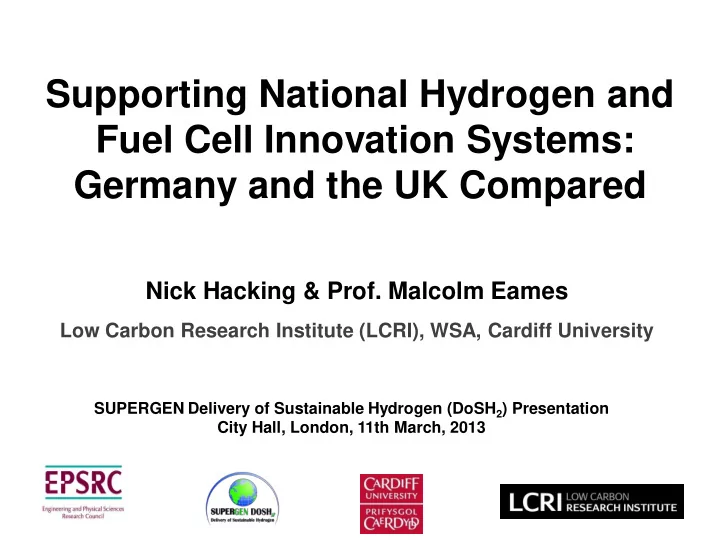

Supporting National Hydrogen and Fuel Cell Innovation Systems: Germany and the UK Compared Nick Hacking & Prof. Malcolm Eames Low Carbon Research Institute (LCRI), WSA, Cardiff University SUPERGEN Delivery of Sustainable Hydrogen (DoSH 2 ) Presentation City Hall, London, 11th March, 2013
Overview • Research Aims • Methodology • German Case Study Areas • UK Case Study Areas • German-UK Comparisons • Comparative Case Study Findings • Conclusions
Research Aims • To undertake an international comparative analysis of the hydrogen and fuel cell (H&FC) innovation systems* in the UK and Germany • Explore lessons for policy and industrial development * the networks of actors and institutions whose activities and interactions bring about the development and diffusion of new technologies and industries
Methodology • Forty nine in-depth qualitative interviews • Nested comparative national and regional case studies • Quantitative analysis of RD&D, market data and interviews
German Case Study Areas Hamburg North Rhine- Berlin Westphalia Baden - Hesse Württemberg
Institutional Mapping of Hydrogen and Fuel Cell (H&FC) Activity - North Rhine-Westphalia (NRW)
German Energy Policy & Decarbonisation • Priority to Renewable Energy Sources Act (EEG) (2000) • Clean Energy Partnership (CEP) (2002) • National Innovation Programme (NIP) (2006) • National Organization Hydrogen & Fuel Cell Technology (NOW) (2008-16) • Memorandum of Understanding (MOU) (2009) • H2 Mobility programme (2009) • Konjunkturpaket II programme (2009) • Energiewende Plan (‘Energy Transformation’) (2010)
UK Case Study Areas Scotland: Outer Hebrides East Coast West & East North-East Midlands Greater South Wales London & the South-East source : UKHA (2008)
Institutional Mapping of Hydrogen and Fuel Cell (H&FC) Activity – London & SE Regions (LSE)
UK Energy Policy & Decarbonisation • Climate Change and Sustainable Energy Act (2006) • Microgeneration Strategy (2006) • Energy Act (2008) • Climate Change Act (2008) • Low Carbon Transition Plan (2009) • Energy Act (2010) • Ultra-low Emission Vehicle (ULEV) Purchase Grant (2011) • UKH 2 Mobility programme evaluation (2012-13)
German-UK Comparisons German public H 2 fuelling stations (2012) = 15 German planned hydrogen fuelling stations: 2013 = 15+ 2015 = 50+ UK public H 2 fuelling stations (2012) = 4 2020 = 1000
10 15 20 25 0 5 1987 1988 1989 1990 1991 1992 Demonstration Start Dates (1987-2012) 1993 1994 1995 1996 New Hydrogen/Fuel Cell 1997 1998 1999 2000 2001 2002 2003 2004 2005 2006 2007 2008 2009 2010 2011 2012 sources : various UK Germany
Cumulative Numbers of PEMFC Developers/Manufacturers (1995-2010) 14 12 10 8 Germany UK 6 4 2 0 1995 1996 1997 1998 1999 2000 2001 2002 2003 2004 2005 2006 2007 2008 2009 2010 source : McDowall, W.
Clustering Region Institutions Clustered? Scotland 37 Yes South East 18 Yes Greater London 15 Likely West Midlands 8 No East 7 No North East 6 No South West 5 No
German Interviewee • “We have a network, working together with the institutes, the universities with private companies, so little and medium ones, and also with the big OEMs … in other industry sectors, and … there might be also some very interesting ideas which you can also maybe collect, yes copy and paste onto your … technology. ” (GTNC1)
UK Interviewee • “I think [we’re] trying to follow the same line as the German economy did, to inspire our company base and be able to produce the right products to benefit those microgen markets ... I think there are many levers we can pull for that, there’s ... direct grant support, information flow, there is collaboration ... and ... feed in tariffs would help .” (UKSCO1)
Summary Comparisons Germany UK R&D base world-class world-class Institutions (total) 443 109 academic 96 31 corporate 347 78 Academic-Corporate Linkage stronger weaker Demos started (2012) 9 4 Active Networks (National & Regional) Yes Yes Clustering Yes Emerging
Summary Comparisons Germany UK Long-term Government Commitment Yes No Targeted Policy Measures Yes No Collectively-agreed public-private vision Yes No National Champions for H&FCs Yes No Priority Given to Automotive Sector Top Medium Priority for Electric Vehicle Prospects Medium-High High Regional Funding for EU/Nat. Demos More Less Views of Capital Markets De-risked Short-term Education and Training Highly valued Less valued Development & Planning Coordination Effective Less Effective
Recommendations For the UK H&FC innovation system to compete internationally… A shared collective vision and political leadership Stable long-term roadmap and policy framework supporting RD&D and markets Stronger industry-university research links, together with support for regional clusters and innovation networks Investment in education and skills, and Public-private partnership to de-risk investment, mobilise capital and address short-term investor horizons
Thank you… ... and thanks to Will McDowall, UCL & Dr. Oliver Ehret, NOW Nick Hacking & Prof. Malcolm Eames Low Carbon Research Institute, Cardiff University eamesm@cardiff.ac.uk hackingn@cardiff.ac.uk
Recommend
More recommend